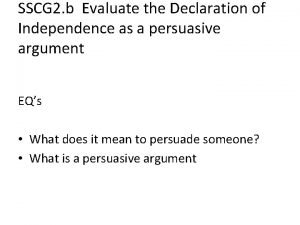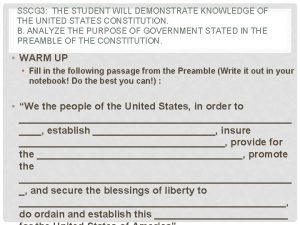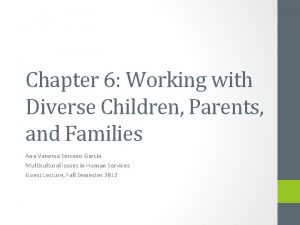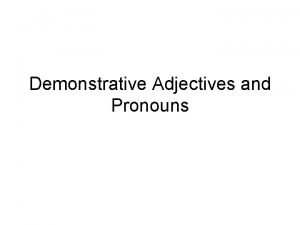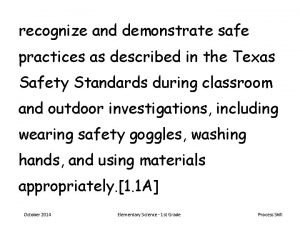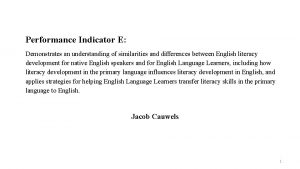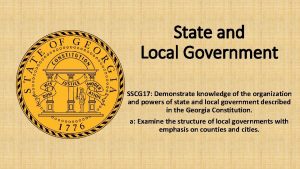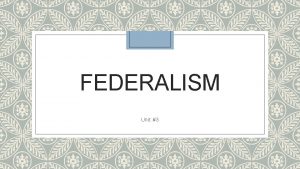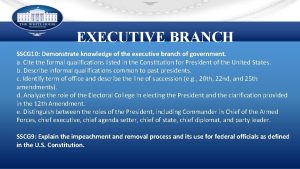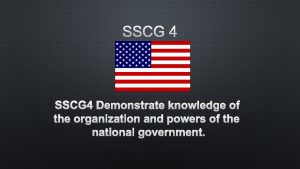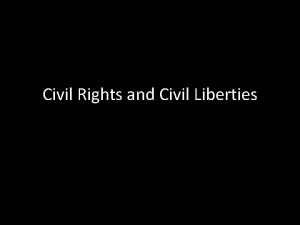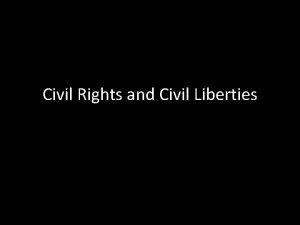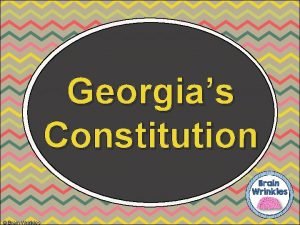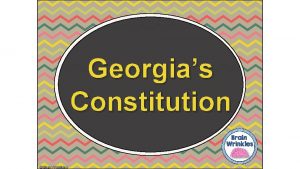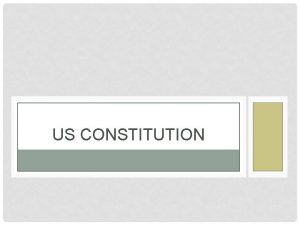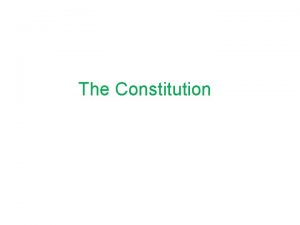The Constitution SSCG 4 Demonstrate knowledge of the

































- Slides: 33

The Constitution SSCG 4 Demonstrate knowledge of the organization and powers of the national government. • Describe the structure, powers, and limitations of the legislative, executive, and judicial branches, as described in the Constitution.

Preamble We the People of the United States, in Order to form a more perfect Union, establish Justice, insure domestic Tranquility, provide for the common defense, promote the general Welfare, and secure the Blessings of Liberty to ourselves and our Posterity, do ordain and establish this Constitution for the United States of America.

ARTICLES of the United States Constitution

Article One Legislative Branch n n Creates a bicameral, Congress Includes a Senate and a House of Representatives.

Article Two Executive Branch n President and Vice-President n n Chosen by Electoral College Explains impeachment

Article Three Judicial Branch n n Establishes Supreme Court (Congress sets up all others) Requires trial by jury for all criminal cases, and defines the crime of treason.

Article Four State Relations n Defines how the states must work together n n n Full faith and credit Extradition Privileges & Immunities

Article Five Amending the Constitution n Two step process n n Proposal Ratification (approval)

Article Six Supremacy Clause n Establishes the Constitution as the supreme law of the land. n Requires that all legislators, federal officers and judges take oaths to uphold the Constitution.

Article Seven Ratification n 9 states will be needed to ratify (approve) the Constitution

Articles Overview Article 1 Article 2 Article 3 Article 4 Article 5 Article 6 Article 7 Legislative Executive Judicial State Relations Amendment Process National Supremacy Ratification

Government Structure SSCG 5 Demonstrate knowledge of the federal system of government described in the United States Constitution. a)Explain and analyze the relationship of state governments to the national government. b)Define and provide examples of enumerated, implied, concurrent, reserved, and denied powers. c)Analyze the ongoing debate that focuses on the balance of power between state and national governments as it relates to current issues. d)Analyze the Supremacy Clause found in Article VI and the role of the U. S. Constitution as the “supreme law of the land. ” e)Describe the roles of Congress and the states in the formal process of amending the Constitution.




Article IV Full Faith and Credit Clause Relation Between States Every state must respect the laws, records, and court decisions of other states. For example, if Georgia gives a person a driver's license, that person can legally drive all of the other states. Extradition If a person commits a serious crime in one state & then escapes to another state, that person must be found & returned to the state where the crime was committed. Citizens visiting another state have the same rights as people who live in that state. Congress controls sale of land has the power to admit new states to the U. S. Every state must have a representative form of government. The federal government will protect and defend all states from other countries. Also, if fighting or violence breaks out inside a state, the federal government will help.

Article V Proposed at the national level. 2/3 of a national convention called by the states 2/3 of both houses of Congress Amendment Ratification at the state level. Process 3/4 of all state legislatures 3/4 of state conventions voting on the amendment must approve

Article VI Supremacy Clause Article 6 includes an important part of the Constitution called the supremacy clause. The Constitution is the highest law of the land. The Constitution, the laws of Congress, and all treaties must be followed by all states. State laws must agree with the Constitution. All members of Congress, the President and all executive branch officials, all Supreme Court justices and federal judges, all members of state legislatures, all governors and state officials, all state judges take an oath of office and swear to obey the United States Constitution. Article VII Ratification Article 7 says that the Constitution became effective when 9 (of 13) states approved or ratified it.

Constitutional Powers and the Role of the States


EXPRESSED Powers ü Powers granted to the NATIONAL government ü Also called ENUMERATED or DELEGATED powers IMPLIED Powers ü Powers granted to the NATIONAL government ü NOT LISTED ü Come from the NECESSARY & PROPER clause (also called the elastic clause) ü Must be tied to the EXPRESSED powers.

Enumerated (aka Expressed or Delegated)

CONCURRENT Powers üPowers shared by both the STATE and NATIONAL government üExamples: Collecting taxes, borrowing money, making and enforcing laws, establishing courts RESERVED Powers üPowers of the STATE (not listed) üArticle 1 prohibits or forbids the states to do certain things such as make its own money, declare war on another country, or make treaties with another country. üAmendment 10 of the Constitution says that powers “not given to the national government and not forbidden to the states are up to the states”. üExamples: Regulate intrastate trade, conduct elections, establish local governments

Prohibited Powers The Constitution lists things which the national government and the state governments cannot do under Article I. cannot pass ex post facto laws means "after the fact" and makes an act illegal after it has been done. For example, a person gambles on a riverboat on Monday and its legal then, but then on Tuesday a law is passed saying anyone who gambled on Monday has committed a crime. cannot suspend writ of habeas corpus This protects people from illegal imprisonment. A person cannot be put in jail or prison until he or she has appeared before a judge. The reason for arrest has to be explained to the person and the judge. Article I says this right cannot be suspended or taken away during times of peace. cannot pass bills of attainder This is a law that punishes a person without a trial cannot grant titles of nobility Congress cannot make anyone a king or queen, duke or duchess, prince or princess. No royal titles can be given by the United States

Federal System in the US Gov’t

Federalism – governmental power is divided between national and state power + =


Amending the Constitution • Two step process – Proposal – Ratification (approval)

Changing the Constitution Changed 27 times by the rules • Step 1: Proposal – 2/3 of Congress – 2/3 of Constitutional Convention • Step 2: Ratification – 3/4 of state legislatures – 3/4 of state conventions


Supremacy Clause • Establishes the Constitution as the supreme law of the land. • Requires that all legislators, federal officers and judges take oaths to uphold the Constitution.

National Supremacy- if a state and federal law contradict, then the federal law wins.

Crash Course Government Video Playlist QUIZLET Full Unit: https: //quizlet. com/156827947
 Texas constitution vs us constitution
Texas constitution vs us constitution Nc constitution vs us constitution
Nc constitution vs us constitution Constitution what is constitution
Constitution what is constitution The constitution lesson 1 principles of the constitution
The constitution lesson 1 principles of the constitution Demonstrate knowledge and understanding
Demonstrate knowledge and understanding Demonstrate good subject and curriculum knowledge
Demonstrate good subject and curriculum knowledge Demonstrate
Demonstrate Sscg(2)
Sscg(2) Sscg meaning
Sscg meaning Sscg(2)
Sscg(2) Why is the senate considered a continuous body
Why is the senate considered a continuous body Sscg 3
Sscg 3 A posteriori knowledge is knowledge that is known by
A posteriori knowledge is knowledge that is known by Personal vs shared knowledge
Personal vs shared knowledge Street knowledge vs book knowledge
Street knowledge vs book knowledge Knowledge creation and knowledge architecture
Knowledge creation and knowledge architecture Knowledge shared is knowledge squared
Knowledge shared is knowledge squared Knowledge claim
Knowledge claim Contoh shallow knowledge dan deep knowledge
Contoh shallow knowledge dan deep knowledge Knowledge shared is knowledge multiplied meaning
Knowledge shared is knowledge multiplied meaning Gertler econ
Gertler econ Demonstrate
Demonstrate Bicultural couples tend to demonstrate extremes in
Bicultural couples tend to demonstrate extremes in Demonstrate two
Demonstrate two Medulla structure
Medulla structure Appropriate demonstrative
Appropriate demonstrative Words that rhyme with crisp
Words that rhyme with crisp Demonstrate
Demonstrate What does this image demonstrate?
What does this image demonstrate? Decided synony
Decided synony Demonstrate your ability
Demonstrate your ability Demonstration purpose
Demonstration purpose The contest on mount carmel
The contest on mount carmel Demonstrate
Demonstrate









